
14 minute read
Covid-19 and offsite take-up
Offsite Manufacturing
WILL COVID-19 ACCELERATE OFFSITE TAKE-UP?
Advertisement
OFFSITE MANUFACTURING PLANTS CONTINUED OPERATING FOR MUCH OF THE COVID LOCKDOWN. WITH FEARS OF A SECOND WAVE, WILL MORE CONSTRUCTION PROJECTS CHOOSE TO EMBRACE FACTORY PROCESSES? WILL MANN ASKS SOME OF THE SECTOR’S KEY PLAYERS, STARTING WITH LAING O’ROURKE
When covid-19 struck in March, it was
only a temporary setback for Laing O’Rourke’s design for manufacture and assembly (DfMA) plants.
“Our factories were running at 75% to 80% operational capacity during the first two weeks of lockdown, but after that, returned to pre-covid productivity levels, once we’d worked out the rules on social distancing,” says Declan McGeeney, Laing O’Rourke head of infrastructure.
“We actually think they have been even productive than before lockdown, which may be due to fewer distractions from project teams visiting – the factories have been left to get on with their work.”
Productivity across Laing O’Rourke sites dropped 50% during that first fortnight of lockdown but its DfMA capability has allowed the contractor to keep projects on schedule.
“On our Soho Place commercial scheme, for instance, we increased the number of MEP components manufactured offsite,” explains McGeeney. “Horizontal risers are not commonly prefabricated – unlike vertical risers – because project teams feel there’s not enough volume to justify it. However, we do prefabricate horizontal risers in hospitals, and we introduced that approach on Soho Place because of the lockdown restrictions, so we could keep the critical path moving along.”
Laing O’Rourke’s positive experience is shared by many across the offsite sector (see boxes). The controlled

working conditions of the factory have made it easier to implement social distancing protocols, while key project elements can continue to progress even when work on site is restricted. With fears of a second covid wave, there is anecdotal evidence of projects being redesigned for offsite to speed up delivery and remove uncertainty.
Could this be a watershed moment for offsite take-up?
Rewind to the uncertain days of March. Like all construction businesses, Laing O’Rourke examined the guidance coming from the Construction Leadership Council (CLC) to understand how they could operate.
Sites were challenging, says McGeeney, but it was more straightforward at the group’s five manufacturing centres: the Centre of Excellence for Modern Construction in Steetley (formerly Explore Industrial Park), Crown House in Oldbury, GRC near Doncaster, Smartwall in Worksop and Select’s accommodation business in Wincham, Cheshire.
“The factory teams have been working together for years and know each other well – whereas there are regular changes of operatives on sites – so we could get the change of culture embedded in our facilities quickly,” explains McGeeney.
“We moved the factory teams to a day shift (7 till 3) and back shift (3 till 10) – we could do that because we didn’t have to worry about noise affecting neighbours, unlike on site.
“Some tasks require workers to be within 2m of each other, such as assembling pipe work for plant rooms at our Crown House facility. For this work, we do a full risk assessment and use special PPE including FFP3 masks.
“Workers receive drawings digitally so they are not handling paper. Clocking in is done through mobiles to avoid people touching the keypad. Operatives work in the same cells and take breaks together – we split up the canteens to allow this.”
During lockdown, Laing O’Rourke manufactured and then – last month – delivered on site the first HS2 permanent structure, a bridge over the M42 near Birmingham. “It was a completely digital build, which would have taken eight weeks traditionally, but we put it up in five days,” says McGeeney.
“With these projects, we are learning what other processes we can move into the factory,” he continues.
Famously, Laing O’Rourke has a ‘70:60:30 target’ – where 70% of construction work is delivered in the factory (the pre-manufactured value or PMV), achieving 60% productivity gains, and 30% programme savings.
“We’re now driving towards 80% of our work being factory-manufactured,”

Laing O’Rourke’s Centre of Excellence for Modern Construction (photo taken before social distancing was introduced)
“On a production line, compared to a site, there are very set processes – critically, you don’t have different trades working around each other.” John Lewis, Aecom
John Lewis Managing director modular, Aecom
Aecom’s modular business is three years old. The company acts as a principal contractor and offers a turnkey service, working with Rogers Stirk Harbour on design, and uses hybrid modules featuring steel structural elements and glulam for the interiors.
Its Tuxford manufacturing facility in Nottinghamshire (top) operated throughout the lockdown, says John Lewis, managing director of Aecom’s modular business.
“We have 30 people normally on the production line which we reduced by half initially, then it went back up,” he says. “The great thing about a production line compared to a construction site is there are very set processes – we have nine stages with clear instructions – about what has to be delivered and when. Critically, you don’t have different trades working around each other.
“So it is much easier to analyse work process and work out where the risk points are. For example, assembling cassettes involves taking panels of sheet material and fixing them to a frame, which requires two people working within 2m of each other. We got round that by creating a bubble – those people only worked together and didn’t do other tasks.”
Aecom’s modular business is currently delivering one of its first projects, a block of 39 single living homes for homeless people in Romford for the YMCA, using modules manufactured in Tuxford.
“We had delivery concerns because the site foundation works were closed for two to three weeks,” says Lewis. “But by creating a social bubble, the foundation team of six workers were able to work together and not interface with other operatives.”
Lewis says Aecom’s modular business has “had enquiries from clients who are trying to make back time lost during lockdown” but thinks the market is turning towards offsite in any case.
“Build quality and sustainability are key factors,” he says. “These are highly engineered modules, with low running costs due to their thermal performance. Net zero during operation is achievable for our modular projects.”
says McGeeney. “The Grange hospital in Gwent was in the high 70s. Ray [O’Rourke, group CEO] wants 90% to 95% by 2025.”
What other work packages could become more factory-friendly? “Structures is one area,” answers McGeeney. “We enter projects later than we would like which can make it harder to change structural elements. Cladding is not consistent across industry. Finishes tend to be done quite traditionally.
“We must deliver the right architecture. But we need to move more towards standard components and get them into BIM libraries, not reinvent the wheel every time. The government is backing that.
“The build is high risk with offsite. Laing O’Rourke can self-deliver and
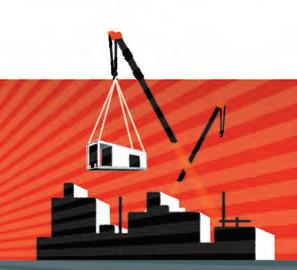
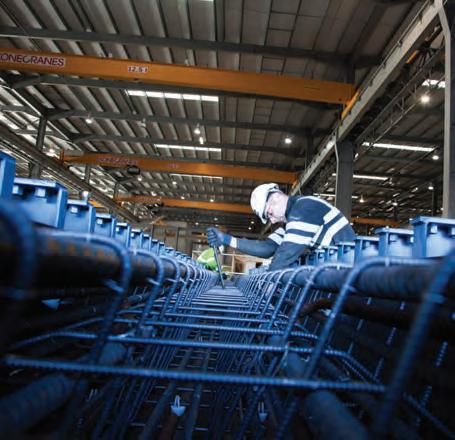
Workers at Laing O’Rourke’s Steetley manufacturing centre Paul Ruddick Chief executive, Reds10
“AI will drive further efficiencies in the design, churning out the most efficient specification.” Paul Ruddick, chief executive, Reds10
Modular specialist Reds10 has its factory in Driffield, 20 miles north of Hull. CEO Paul Ruddick says demand has barely slowed – if anything increased – since the covid-19 pandemic struck in March.
“Our plant went down to 50% operational capacity for six weeks but was back up to 100% after that,” he says.
“We followed the guidance from the CLC, who did the best they could in a tricky situation and did at least give us a licence to operate.
“We have 90 operatives working in two factories side by side at the site and we keep the two apart and also have two separate canteens. Teams work in ‘pods’ of roughly 10 workers and have no interaction with others. Obviously some tasks require two or more people, so for these, face guards and other PPE have to be worn, with a break after 15 minutes, in line with the guidelines.”
Reds10’s facility is in East Yorkshire, arguably the ‘heartland’ of the offsite sector, and Ruddick says other factories in the area are currently “flat out, scrambling for skills”.
“That’s an indicator of how high demand is,” he says. “Offsite does help de-risk projects, so that’s a consideration if there is another wave and lockdown. Our teams can keep working, we’ve got large areas to set down materials, people can drive to work and know who they will be next to every day.”
One of Reds10’s current projects is an office block for the Imperial War Museum in London. Other recent orders include CT scanner buildings and maternity wards in healthcare and it is on the Department for Education’s offsite framework.
Ruddick believes the product will become more competitive. “Our PMV is 85% for a project like an open plan office building,” he says, “though the CT scanner buildings were near enough 100%.
“AI will drive further efficiencies in the design, churning out the most efficient specification, and our suppliers will then feed into the model, providing the most efficient, low carbon solution.”
Reds10 is working on an office block for the Imperial War Museum, London
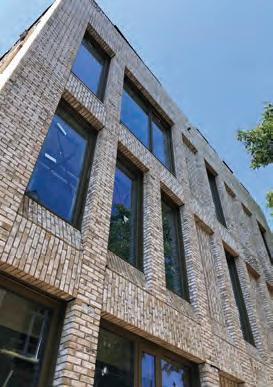
manage out that risk. But others get put off quite quickly. Getting digital embedded right from tender is key so we can build the project virtually before we reach site.
“We need to deliver faster, and with fewer people,” he continues. The company’s planned Advanced Manufacturing Facility, to support its residential business, “will use robotics for 90% of the precision process work”, McGeeney reveals. The plant, which will be located next to the Centre of Excellence, will aim to manufacture 10,000 homes a year. It is at “business case stage”, McGeeney says.
“Already we use robotics for cutting pipework at our Crown House factory and at our GRC plant we use 3D printing for mould production,” he adds.
McGeeney senses a “marked shift” in attitudes to offsite since covid-19 arrived.
“We have to plan for any second wave of covid so our projects are not impacted,” he says. “At Laing O’Rourke, we have more enquiries coming in. Some clients have asked us about redesigning a project to suit offsite or to prefabricate elements like the structure, the lift shaft, the MEP.
“Even our competitors are asking our businesses about how to embed offsite within their business. Some 50% of turnover at Crown House and Expanded is outside Laing O’Rourke, so we have a chance to shift opinion in the market – we know we can’t do it all ourselves.” ●

Above right:
Installation of Offsite Solutions bathroom pods on a Berkeley Homes development Below: Premier Modular extended working hours at its Yorkshire factories
David Harris
Managing director, Premier Modular
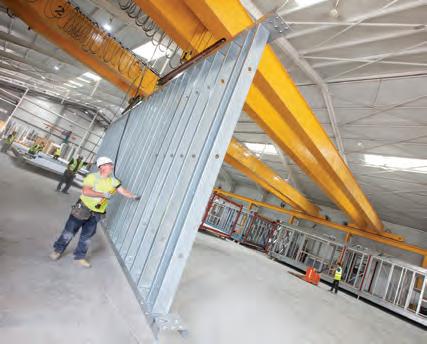

Offsite Solutions is a specialist bathroom pod manufacturer, with four factories in Somerset, which total 200,000 sq ft (18,600 sq m). Facilities include GRP (glass reinforced plastic) and steel-framed pod manufacturing, steel base frame fabrication and a unit for fitting out, testing and despatch.
“All factories remained open throughout lockdown at slightly reduced capacity,” says James Stephens, managing director.
“The key change to operating procedures created more space between pods. This means fewer units on each production line and only one person permitted to work in a pod at a time. The exception to that is the fitting of cabinets or shower screens. This work requires two people, so they are required to wear PPE.”
Stephens continues: “We installed hand wash stations to all the main points of entry to each factory and appointed staff to monitor hand washing to ensure hygiene processes were adhered to. We also put hand sanitising units on every production line and increased the cleaning regime. Premier Modular, also based in Driffield, has five factories spanning 12,000 sq m at its site in East Yorkshire.
“All our factories remained at capacity throughout the lockdown and continue to do so,” says managing director David Harris. “During the peak, we had a range of building types going through the factory for permanent and interim projects, including defence, school buildings and site accommodation.”
“We extended working hours to create more space in the factory while minimising the impact on productivity and output. Work was separated out in the factory by having teams working in specific cells. Extra signage gave clarity on new ways of working along with daily meetings and toolbox talks.
“Our buildings move through the factory in a sequential process, so it is relatively easy to avoid work being carried
“We generally have one person working on a pod at any one time although it is possible to fit out the inside of a bathroom while another member of our team is installing plumbing or electrics externally and still maintain 2m social distancing. This would not be possible on site where work on bathrooms is much more confined.”
On site, Stephens says it is relatively easy to maintain social distancing requirements for pod installation as only two operatives are needed.
“Some of our clients found it productive to accelerate their pod deliveries during the lockdown,” he adds. “With reduced numbers of trades on site at this time, this allowed pods to be sited much more quickly.”
Stephens says that Offsite Solutions fulfilled all its customer requirements for bathroom pods during the lockdown period, supplying hotels, student accommodation, build-to-rent schemes and a care home project.
“We also achieved a record level of enquiries and quotations in April,”
he adds. out by different trades in the same area at the same time.”
Premier’s PMV is around 80% and Harris says installation work on site is done by small crews so social distancing requirements had minimal impact.
The company worked with BAM at Nightingale Exeter, designing and installing five single storey modular buildings totalling 1,700 sq m in just four weeks.
“Looking forward, we are anticipating increased demand for education projects which were delayed by the pandemic,” Harris says. “The pressure to deliver these buildings in a shorter time to meet the demand for school places is likely to result in wider use of offsite construction. With the government presumption in favour of offsite, even in a smaller economy, we are expecting the number of offsite projects to increase.”
‘MEMBERS ARE THE LIFEBLOOD’
THE CIOB’S NEW CEO CAROLINE GUMBLE TALKS TO CM
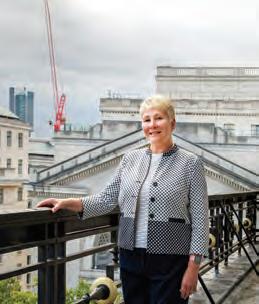
constructionmanagermagazine.com
CONSTRUCTION m ANAge R | j UN e 2020 | www. CONSTRUCTION m ANAge RmAgAz INe.CO m
CORONAVIRUS HOSPITALS
01.CMSept19.Cover.indd 1
OFFSITE MANUFACTURING SPECIAL | ISG’S BREWERY REBUILD | PRODUCTIVITY SURVEY
20/08/2019 15:38 01.CMJune20.Coverfinal.indd 1
constructionmanagermagazine.com
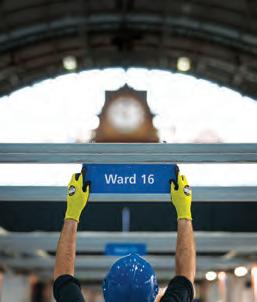
TeSTInG TIMeS
THe PROjeCT TeAmS wHO BUILT THe COVID HOSPITALS
CONSTRUCTION MANAGER | NOVEMBER/DECEMBER 2019 | WWW.CONSTRUCTIONMANAGERMAGAZINE.COM
LINCOLN CATHEDRAL
eMBODIeD CARBOn | WInVIC’S SMART SenSORS |
AnnuAL BIM SuRVeY
19/05/2020 12:27 01.CMNovDec19.Coverfinal.indd 1
CONSTRUCTION MANAGER | FEBRUARY 2020 | WWW.CONSTRUCTIONMANAGERMAGAZINE.COM
WANDSWORTH RECLADDING
01.CMFeb20.Cover.indd 1
constructionmanagermagazine.com
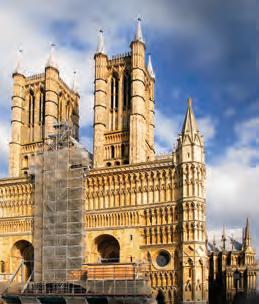
GOLDEN GLOW
LASER GUNS HELP LINCOLN CATHEDRAL’S CONSERVATION
CONSTRUCTION MANAGER | JANUARY 2020 | WWW.CONSTRUCTIONMANAGERMAGAZINE.COM
GLEEDS CEO PROFILE
constructionmanagermagazine.com

READY FOR THE DIGITAL DISRUPTORS
GLEEDS CEO GRAHAM HARLE ON ADAPTING TO A FAST-CHANGING INDUSTRY
MCALPINE CEO PROFILE | STRUCTURAL STEEL SPECIAL | BIM STANDARDS CPD
21/10/2019 15:07
FEBRUARY 2020 For members of the CIOB
constructionmanagermagazine.com

CLAD TIDINGS
ONE LOCAL AUTHORITY’S RECLADDING CHALLENGE
01.CMJan20.Cover.indd 1
CONSTRUCTION MANAGER | MARCH 2020 | WWW.CONSTRUCTIONMANAGERMAGAZINE.COM
ETHNIC MINORITIES IN CONSTRUCTION
CONSTRUCTION’S FAIREST PAYERS | WILLMOTT DIXON’S PILGRIMAGE | HS2 ENABLING WORKS
MARCH 2020 For members of the CIOB
constructionmanagermagazine.com

THE CHANGING FACE OF CONSTRUCTION
HOW ETHNIC MINORITIES FEEL ABOUT WORKING IN THE INDUSTRY
3D MODELS FOR FIRE SAFETY | GRAHAM CEO PROFILE | PRECAST CONCRETE HOUSING
20/01/2020 12:04 01.CMMar20.Coverfinal.indd 1
TURNER & TOWNSEND MD PROFILE | LANDSEC’S NEW OFFICE CONCEPT | MODULAR TIMBER HOMES
30,887*
The largest circulation of any UK construction magazine.
58,000
Email newsletters reaching CIOB members and other construction professionals. Unparalleled access to the key decision makers leading the UK construction industry. *ABC audited July 2019 to June 2020










